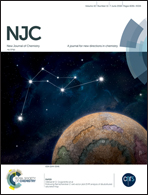Carbon fibers as three-dimensional current collectors for silicon/reduced graphene oxide lithium ion battery anodes with improved rate performance and cycle life†
Abstract
A lithium ion battery (LIB) anode is prepared consisting of silicon and a reduced graphene oxide (Si/r-GO) composite deposited on a three-dimensional (3D) carbon fiber (CF) current collector. The morphology, structure and textural properties of the as-prepared Si, Si/r-GO composite and Si/r-GO/CF electrode are characterized using scanning electron microscopy, X-ray diffraction and N2 adsorption–desorption isotherms, respectively. The reversible capacity of the Si/r-GO/CF electrode (>1000 mA h g−1 at the rate of 0.1C) is found to be significantly higher than that of a Si/r-GO electrode with a traditional 2D copper foil collector. Moreover, the Si/r-GO/CF electrode exhibits an excellent rate performance of 280 mA h g−1 even at a rate of 10C due to the effective conductivity improvement and a capacitor-like behavior offered by the CF networks. In addition, the Si/r-GO/CF coin cell shows a low resistance of 20 Ω in charge transfer. Finally, the CF skeleton serves as a solid scaffold, which inhibits the aggregation of the Si/r-GO composite during usage, and therefore leads to a long cycle life (i.e., a capacity retention of more than 95% after 100 cycles).



 Please wait while we load your content...
Please wait while we load your content...